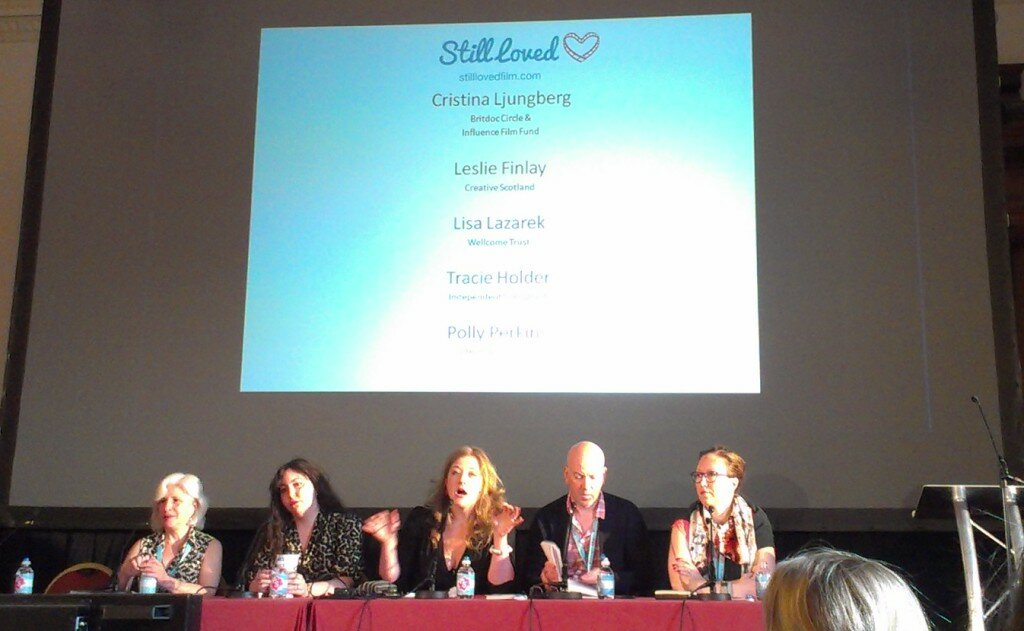Alternative Funding
Why Your Documentary Grant Proposal Should be Like a Great Ski Run

Tracie Holder (Women Make Movies), Lisa Lazareck (Wellcome Trust), Polly Perkins (Producer), Leslie Finlay (Creative Scotland), Cristina Ljungberg (Influence Film Foundation)
At Sheffield Doc/Fest in 2015 one of the panels, which consisted of a range of funders and filmmakers, discussed how documentary producer/directors could best approach writing grant proposals for documentary funds. Writing proposals is generally the thing that visually-driven filmmakers like doing least. And, as Tracie Holder, Production Assistance Program Consultant to NYC-based Women Make Movies, pointed out: it’s hard to know what a good proposal looks like as filmmakers never see other people’s proposals.
Tracie explained that a written proposal is your introduction to a funder, so it should establish confidence that you can deliver a fantastic film.The reader should be able to “ski down the proposal without hitting any red flags”. Scroll down to see an extract of the successful proposal for Shakespeare Behind Bars, courtesy of filmmakers Jilann Spitzmiller and Hank Rogerson of Philomath Films; it starts around p.225.
When asked what gives a funders confidence in an application, they reeled off a wishlist of criteria. The filmmaker should:
- Have read the guidelines online before filling in the application form – use this information to think about exactly how your film fits the funder’s mission.
- Have called and talked through the proposal before submitting the application although Tracie cautioned that US foundations don’t want to talk to filmmakers in advance. A 10-minute conversation with a funder is more effective than five pages of text.
- Be able to describe the STORY (as opposed to the concept/subject). Writing a proposal is like an architect creating a blueprint. Use visual images/descriptions – describe characters and place – make them come alive off the page.
- Articulate why the funder should they support the project i.e. how does it meet the funder’s specific criteria? It’s also a good idea to identify and articulate why this film should be funded NOW. Funds can’t fund all the films that are a good fit, so they often make their funding choices by focusing on applications that are most timely/urgent. Find the reason why you film has to be funded now.
- Communicate the vision / style in which the film will be shot. Funders are always looking for films that have a light touch and filmmakers who can use humour in order to engage audiences with difficult subjects. Lisa Lazareck from the Wellcome Trust, which funds films with a biomedical angle, described feeling trepidatious about watching I Am Breathing, a film about a man dying – but it turned out to be very poignant and funny, which won her over.
- Have identified and understand the target audience. Be honest about identifying the RIGHT audience. It doesn’t necessarily have to be big international cinema audience – a small and focused audience is OK, but how will you reach them?
- Have a well thought out distribution strategy – What’s your distribution strategy – TV, festivals, SVOD, theatrical? If you have an issue-driven film have you thought about bringing on board an impact producer to maximize your chances of getting your film seen by the right people? Charities can also help support an application if they write a letter of support saying that they can promote the film to their subscriber base or arrange screenings – this can help to demonstrate a ready and interested audience waiting for your film to be made.
- Have a realistic budget in place – detail how much it will cost to make the film, including your own fee; trying to save money by not budgeting to pay yourself looks amateurish. Respect yourself and pay yourself national union rates.
- Have a good finance plan outlining where you have already secured funding from and who else you plan to approach; does it make sense in the context of the film you wan to make? If you put a list of inappropriate funders in a finance plan it undermines your overall proposal.
In addition a proposal should be accompanied by a concise cover letter that demonstrates that you understand the funder and their funding criteria and tells the story in a couple of paragraphs. Filmmakers often struggle to condense their idea , but you should be able to convey the story in a variety of formats – a one-liner, a paragraph, a one-pager – suitable for a variety of different situations.
Before you press send, make sure that you really are ready to submit:
- Get objective friend to read the application to check all the questions have been properly answered.
- Take out all negatives and question marks.
- Have you considered how you are going take your film from Point A to Point B? If you are new filmmaker, hook up with someone more experienced. Do you have a mentor or executive producer onboard to guide you?
And once you’ve submitted? Don’t sit back and wait for the phone to ring, advises Tracie. Funding is a lot about relationships, so you need to be constantly making new contacts and nurturing existing relationships. Attending festivals, conferences and markets will help you meet new people. Taking part in development labs and pitch forums puts you on the radar of funders, who will track your progress over many months and years until it feels like the right time, and you have a project that is a good fit for them. In other words, play the long game.
Excerpt from :


Discussion
Comments are disallowed for this post.
Comments are closed.